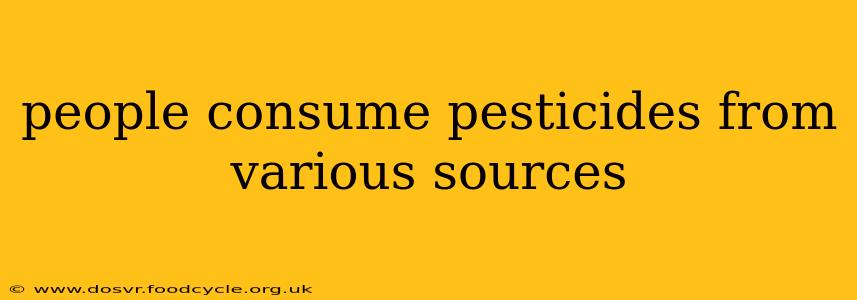How People Consume Pesticides: Unseen Pathways to Exposure
Pesticides are ubiquitous in modern agriculture and pest control, yet understanding how people are exposed to these chemicals is crucial for public health. While direct spraying is a clear source, the routes of pesticide consumption are far more nuanced and often indirect, leading to chronic low-level exposure that can have significant health consequences. This article explores the various ways people inadvertently consume pesticides, highlighting the importance of awareness and preventative measures.
What are the main sources of pesticide exposure?
This is a multifaceted question, as exposure pathways are numerous and interconnected. Major sources include:
-
Food: This is arguably the most significant source of pesticide exposure for many. Fruits, vegetables, grains, and other foods can contain pesticide residues from agricultural practices. Even washing produce may not entirely remove these residues. The level of residue depends on various factors including the type of pesticide used, application methods, and time elapsed since application. Organic produce generally has lower levels of pesticide residues, but they are not entirely pesticide-free.
-
Water: Pesticides can contaminate groundwater and surface water through runoff from agricultural fields and improper disposal. Drinking contaminated water, or using it for cooking or bathing, can lead to pesticide ingestion.
-
Air: Pesticide spraying, even in distant agricultural areas, can lead to airborne particles that people inhale. This is particularly concerning for individuals living near agricultural lands or areas with intensive pesticide use.
-
Soil: Pesticides can persist in soil for extended periods, contaminating nearby plants and potentially entering the food chain through root uptake. Children playing in contaminated soil are at heightened risk of dermal exposure and ingestion.
-
Occupational Exposure: Individuals working in agriculture, pest control, or pesticide manufacturing face the highest risk of direct exposure through skin contact, inhalation, and ingestion. This often involves higher concentrations of pesticides than those found in the general population.
What are the most common types of pesticides found in food?
Identifying specific pesticides is complex and varies regionally. However, organophosphates, organochlorines, carbamates, and pyrethroids are among the commonly detected pesticide classes in various food products. The specific types and concentrations depend on the crop, growing practices, and pesticide regulations in place. Monitoring data from government agencies (like the EPA in the US or EFSA in Europe) provides valuable insights into pesticide residue levels in different food items.
How can I reduce my pesticide exposure?
Minimizing pesticide exposure requires a multi-pronged approach:
-
Choose organic produce: Opting for certified organic fruits and vegetables reduces your exposure to synthetic pesticides.
-
Wash produce thoroughly: Even organic produce should be washed to remove dirt and any residual pesticides. Consider using a vegetable wash, though effectiveness varies.
-
Filter your drinking water: A good water filter can remove many contaminants, including some pesticides.
-
Support sustainable farming practices: Advocate for policies that promote sustainable agriculture and reduce pesticide reliance.
Are there long-term health effects associated with low-level pesticide exposure?
The long-term health effects of low-level pesticide exposure are a subject of ongoing research. Studies suggest potential links to various health issues, including neurological disorders, reproductive problems, certain cancers, and developmental delays in children. The severity of these effects can vary depending on the type and amount of pesticide, duration of exposure, and individual susceptibility.
What government agencies regulate pesticides?
Pesticide regulation varies by country, but most have agencies dedicated to ensuring the safe use and registration of pesticides. These agencies establish acceptable levels of pesticide residues in food and monitor compliance. Examples include the Environmental Protection Agency (EPA) in the United States and the European Food Safety Authority (EFSA) in Europe.
Understanding the various pathways through which people consume pesticides is paramount for mitigating the associated risks. By making informed choices about food, water, and lifestyle, individuals can significantly reduce their exposure and safeguard their health. Further research and public awareness are essential to address this complex issue and protect vulnerable populations.
